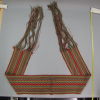Relatives/Heritage items
Displaying 1861 - 1880 of 4694 Relatives
Browsing allows you to see all the records for relatives and heritage items in the GKS. You can also search by material made, and/or filter by nations. To search by material made, type the material's name, by example 'leather', in the box below and click “Apply.” You can select multiple nations from the dropdown list by pressing “Ctrl” (on PC) or “Command” (on Mac) and clicking, then select “Apply.”
These two quartz biiwaanak (arrowheads) were collected by British Army officer Jasper Grant between 1800-1809. Although the maker is unrecorded and the exact place of origin is not certain, they are of Great Lakes origin.
Both arrowheads currently reside at the National Museum of Ireland.
A brass cast finger-ring, lathe shaped; exchanged with the Fieldmuseum of Natural History, Chicago, ex Wyman coll.; from a burial near Green Bay, Wisconsin
A diagonal finger woven sash; "Shaman's sash or waist belt, made by the wife of Mósihât, a Menomini shaman of the highest degree and worn by him. This is made of wool yarn purchased at trader's store, the workmanship being purley aboriginal"; obtained from W
A beaver turban lined with cotton cloth and beaded with variously coloured seed beads. The boy's cap was obtained by Mr. Jones from a Mesquakie woman near Tama, Iowa.
A bead-woven band decorated with silk ribbons, collected by William Jones from a Mesquakie woman near Tama, Iowa.
Black steatite pipe with rings around tip of stem. Pipe bowl is flared. Attributed to Shawnee Chief Tecumseh.
The relative is a Haudenosaunee gahswęhdaˀ wampun belt dated to 1800-1885. It bears motifs of two human figures on a white background connected by a solid dark line. One human figure is made out in white beads and appears to be holding a hatchet. The
This pipe bowl was collected by British Army officer Jasper Grant between 1800-1809. It is of Great Lakes origin, possibly Anishnaabe (Ojibwe.
A bead-woven band decorated with silk ribbons. Exchanged with the Field Museum of Natural History, Chicago, part of Wyman collection; obtained by Wyman among the Winnebago.
A finger woven sash, known as ceinture flechee or Assomption sash; probably of Algonquin or French-Canadian manufacture
Woven woolen yarn garter pendants with dyed quills, glass beads, copper and tin cones and red dyed animal hair. Collected by Captain Andrew Foster at Michilimackinac or Detroit, 1793-1795.
Black velveteen men's dance aprons with floral overlay beadwork. Anishnaabe. Purchased by George Heye from unknown source in 1908.
One loom beaded garter of cotton yarn and multicoloured seed beads, ends of attached red/black wool yarn fringes are twisted togther; obtained from the Menomini, Wisconsin and purchased from William Jones.
A shoulder bag with beaded pictorial motifs of a man in a feather headdress, a tipi, and tree on the front of the pouch and star and concentric circle motifs on the strap. Attributed to Chief Waubuno (John P. Wampum), Moravian Reserve in the Cumberland
One pair of moccasins of hard-sole type with beadwork decoration; "obtained from an Ojibwa woman, Turtle Mountain, North Dakota"; Anishinaabe
One loom beaded garter of cotton yarn and multicoloured seed beads, ends of attached red wool yarn fringes are twisted togther; obtained from the Menomini shaman "Shunien" and donated to the museum by W. J. Hoffmann.
This is a colour lithograph of an original painting by Cornelius Krieghoff. It is of a Huron hunter calling moose, done in 1861-1874.
Hide garter with cross and checkerboard motif. Made of hawk feathers, quills and seed beads, with metal cones and dyed red hair. Collected by Captain Andrew Foster at Michilimackinac or Detroit, 1793-1795.
Birch bark cutouts of flowers and leaves used to trace beadwork patterns, with a birch bark folder. Collected by Frances Densmore in the 1920s.
Gouge made of black, brown stone. Found in Markham, Ontario. Dr. Oronhyatekha Archaeology Collection.
 Knowledge Sharing Platform
Knowledge Sharing Platform




















